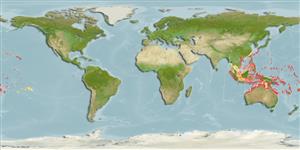>
Eupercaria/misc (Various families in series Eupercaria) >
Scaridae (Parrotfishes) > Scarinae
Etymology: Hipposcarus: Greek, ippos = horse + Latin, scarus = a fish cited by ancient writers; 1601 (Ref. 45335).
More on author: Valenciennes.
Environment: milieu / climate zone / depth range / distribution range
Ecologia
marinhas associadas(os) a recifes; intervalo de profundidade 0 - 40 m (Ref. 37816). Tropical; 30°N - 24°S, 95°E - 141°W
Pacific Ocean: Cocos-Keeling Islands and Rowley Shoals in the eastern Indian Ocean to the Line and Tuamoto islands, north to the Ryukyu Islands, south to the Great Barrier Reef and New Caledonia. Replaced by Hipposcarus harid in the Indian Ocean.
Tamanho / Peso / Idade
Maturity: Lm ? range ? - ? cm
Max length : 60.0 cm TL macho/indeterminado; (Ref. 9710); common length : 48.0 cm SL macho/indeterminado; (Ref. 37816)
Espinhos dorsais (total): 9; Raios dorsais moles (total): 10; Espinhos anais 3; Raios anais moles: 9. Small juveniles are light brownish with a broad longitudinal orange band; the primary phase is a whitish brown to light gray with a yellowish tail; the terminal phase is light blue and green (Ref. 1602, 48636). Adults best recognized by the shape of the head (Ref. 48636).
Inhabits turbid lagoons more than outer reef areas. Usually seen in aggregations; females usually in small groups (Ref. 48636). Feeds on benthic algae (Ref. 89972). Minimum depth reported taken from Ref. 128797. Large adults may occur to depths of at least 40 m.
Life cycle and mating behavior
Maturidade | Reprodução | Desova | Ovos | Fecundidade | Larvas
Oviparous, distinct pairing during breeding (Ref. 205).
Randall, J.E., G.R. Allen and R.C. Steene, 1990. Fishes of the Great Barrier Reef and Coral Sea. University of Hawaii Press, Honolulu, Hawaii. 506 p. (Ref. 2334)
Categoria na Lista Vermelha da IUCN (Ref. 130435)
Ameaça para o homem
Reports of ciguatera poisoning (Ref. 130160)
Utilização humana
Pescarias: espécies comerciais
Mais informação
ReferênciasAquaculturaPerfil para aquaculturaEstirpesGenéticaElectrophoresesHereditariedadeDoençasProcessamentoNutrientsMass conversion
ColaboradoresFotografiasStamps, Coins Misc.SonsCiguateraVelocidadeTipo de nataçãoÁrea branquialOutras referênciasCérebrosVisão
Ferramentas
Relatórios especiais
Descarregue XML
Fontes da internet
Estimates based on models
Preferred temperature (Ref.
123201): 24.8 - 28.9, mean 27.7 °C (based on 518 cells).
Phylogenetic diversity index (Ref.
82804): PD
50 = 0.7500 [Uniqueness, from 0.5 = low to 2.0 = high].
Bayesian length-weight: a=0.01175 (0.00722 - 0.01913), b=3.02 (2.88 - 3.16), in cm total length, based on LWR estimates for this species & (Sub)family-body (Ref.
93245).
Nível Trófico (Ref.
69278): 2.0 ±0.1 se; based on diet studies.
Resiliência (Ref.
120179): Elevada, tempo mínimo de duplicação da população menor que 15 meses (K=0.5).
Fishing Vulnerability (Ref.
59153): Low to moderate vulnerability (27 of 100).
Nutrients (Ref.
124155): Calcium = 43.9 [25.2, 80.3] mg/100g; Iron = 0.713 [0.385, 1.197] mg/100g; Protein = 18.8 [16.7, 20.6] %; Omega3 = 0.0999 [, ] g/100g; Selenium = 42.2 [24.0, 80.9] μg/100g; VitaminA = 30.4 [9.0, 104.6] μg/100g; Zinc = 1.44 [0.99, 2.25] mg/100g (wet weight);
